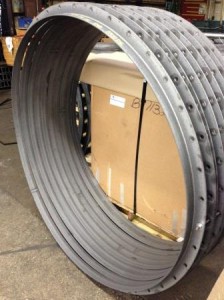Angle iron is a common standard structural steel shape. Angles are L-shaped cross sections made by hot or cold rolling at the mill. The most common angle iron used for manufacturing OEM products in the USA is A36 a standard alloy identified by ASTM. A company that specializes in curving metals could be asked to price bending angle iron to make any OEM product. To name a few applications, angles can be used in agricultural equipment, pneumatic conveying systems, tank stiffeners, manholes, construction equipment, angle rings for ductwork, antenna or satellite housings, and also helical strakes. Angles can be rolled into rings in different orientations. They can be rolled leg-in (stiffeners), leg-out (flanges), apex-in (wheels), apex-out, off-axis and lastly helical (stringers or strakes).

A major OEM angle product is the angle ring. The majority of angle rings are also called angle flanges. Angle flanges are rolled leg out and are commonly provided with or without bolt holes. Angle rings that are sized from 3 inch to 71 inch diameter often come with standard bolt patterns. Bolt holes are commonly put in the horizontal leg. The holes can be specified as being punched with round or slotted holes. When used in OEM products, tight tolerances of +/- 1/16 inches can be held using a template or a go/no go gauge. The tolerance helps when matching up two mating flanges that will be bolted together.
Angle iron has high strength, stiffness, toughness, and ductile properties. However, it does not actually bend very easily. The most natural way to bend an angle iron is apex in or out but most angle rings are rolled being in or out. What happens is that the bending causes the angle to twist. The reason is that the vertical leg of the angle is being bent the “easy-way” or like a belt, while the horizontal leg is being bent the “hard-way” like a washer. The twist is caused because the neutral-axis is somewhere between the two legs. All the material inside the neutral axis compresses while all material outside the axis stretches.
To determine the cost of the OEM product one must look at the cost of labor, raw material, and transportation of the angle product. Depending on the quantity ordered, labor cost per piece can vary, but often you will find that the cost decreases as the quantity increases. If only a few parts are ordered, the set-up time could be a significant part of the total cost. The raw material cost also decreases as the quantity increases. This is due to the fact that quantity discounts exist when buying raw material. You can often buy directly from the mill cutting out extra cost that you would have to pay to a steel services center. Lastly shipping costs are usually minimal, but there are costs associated with processing the order, material handling, packaging, inventory storage, and transportation.
[maxbutton id=”1″]







